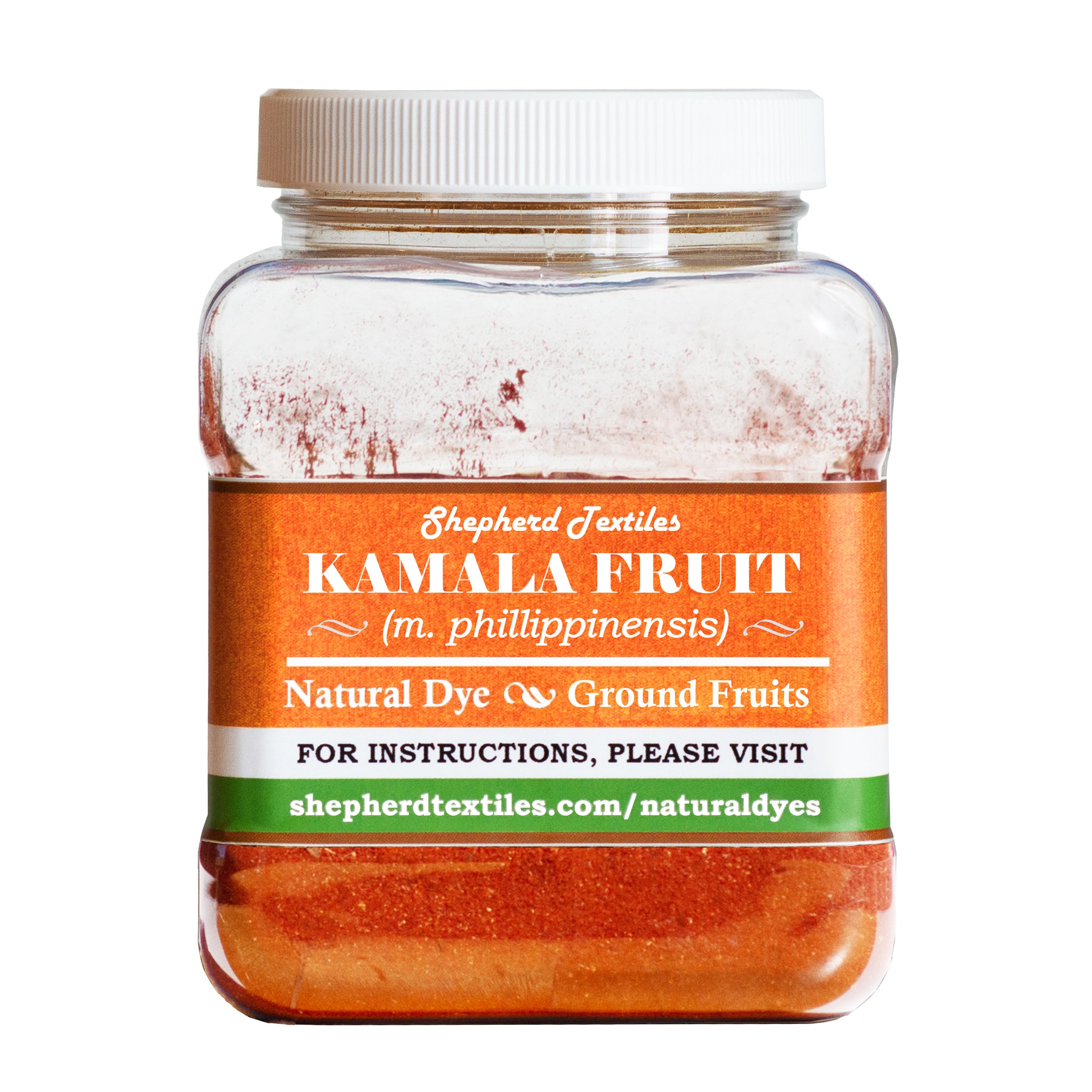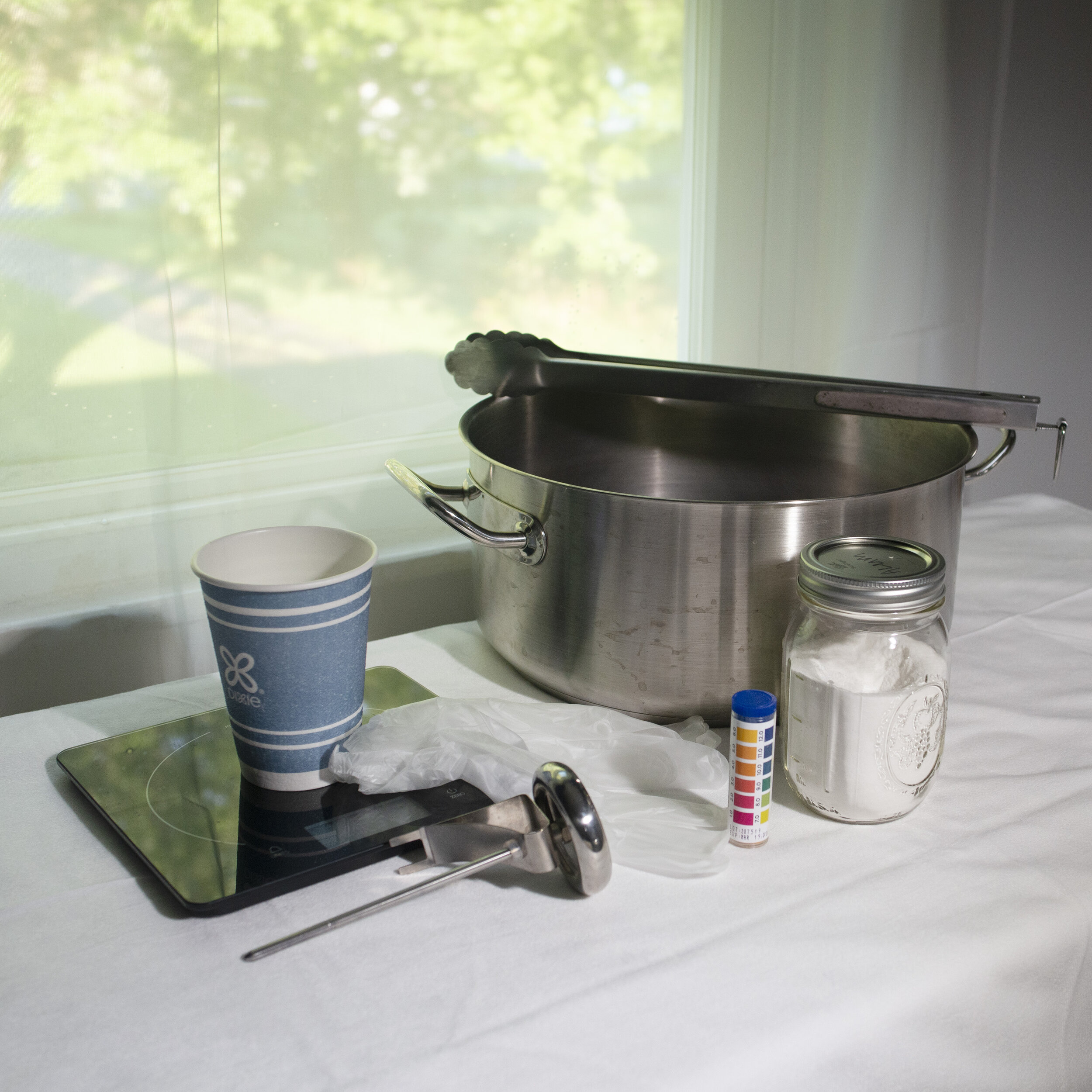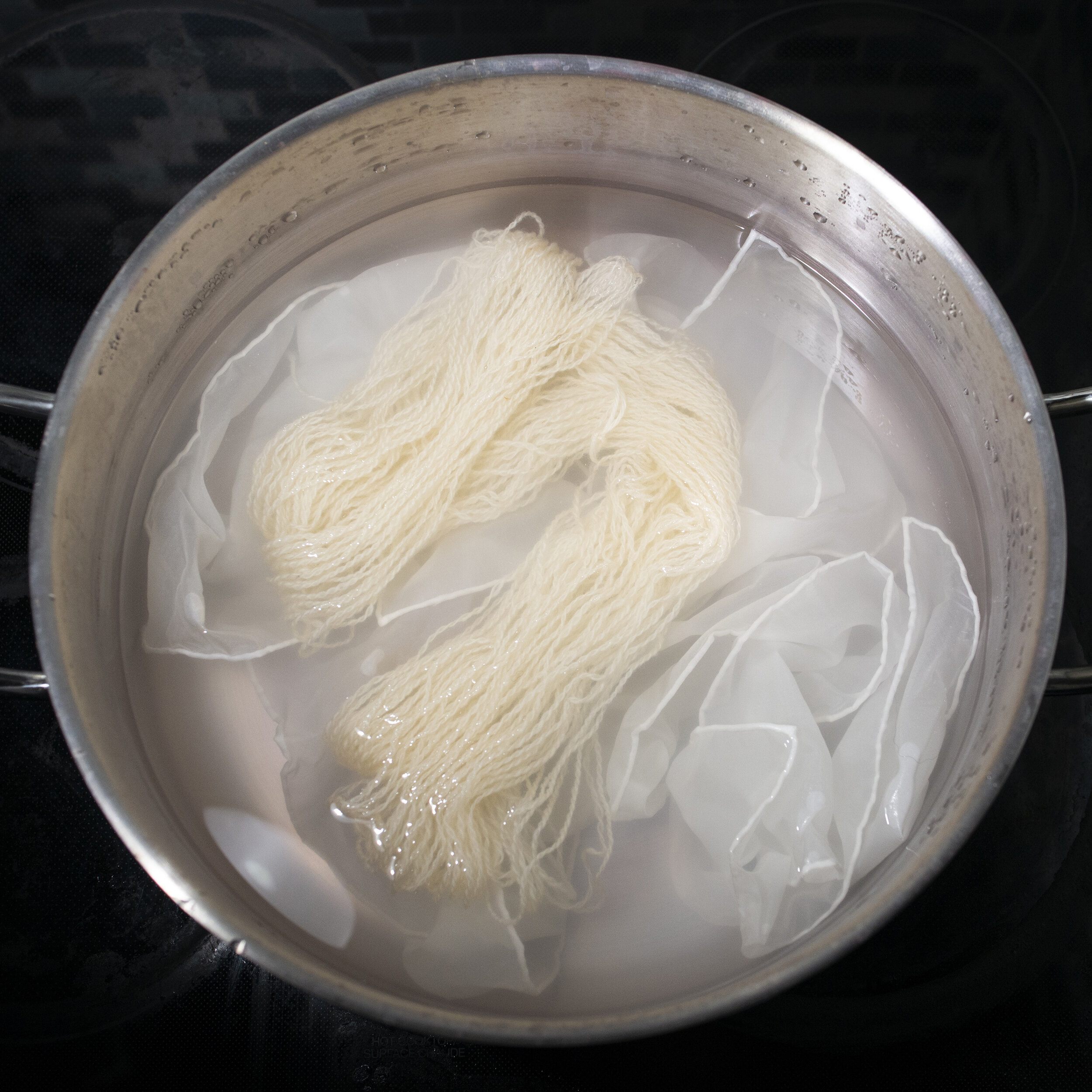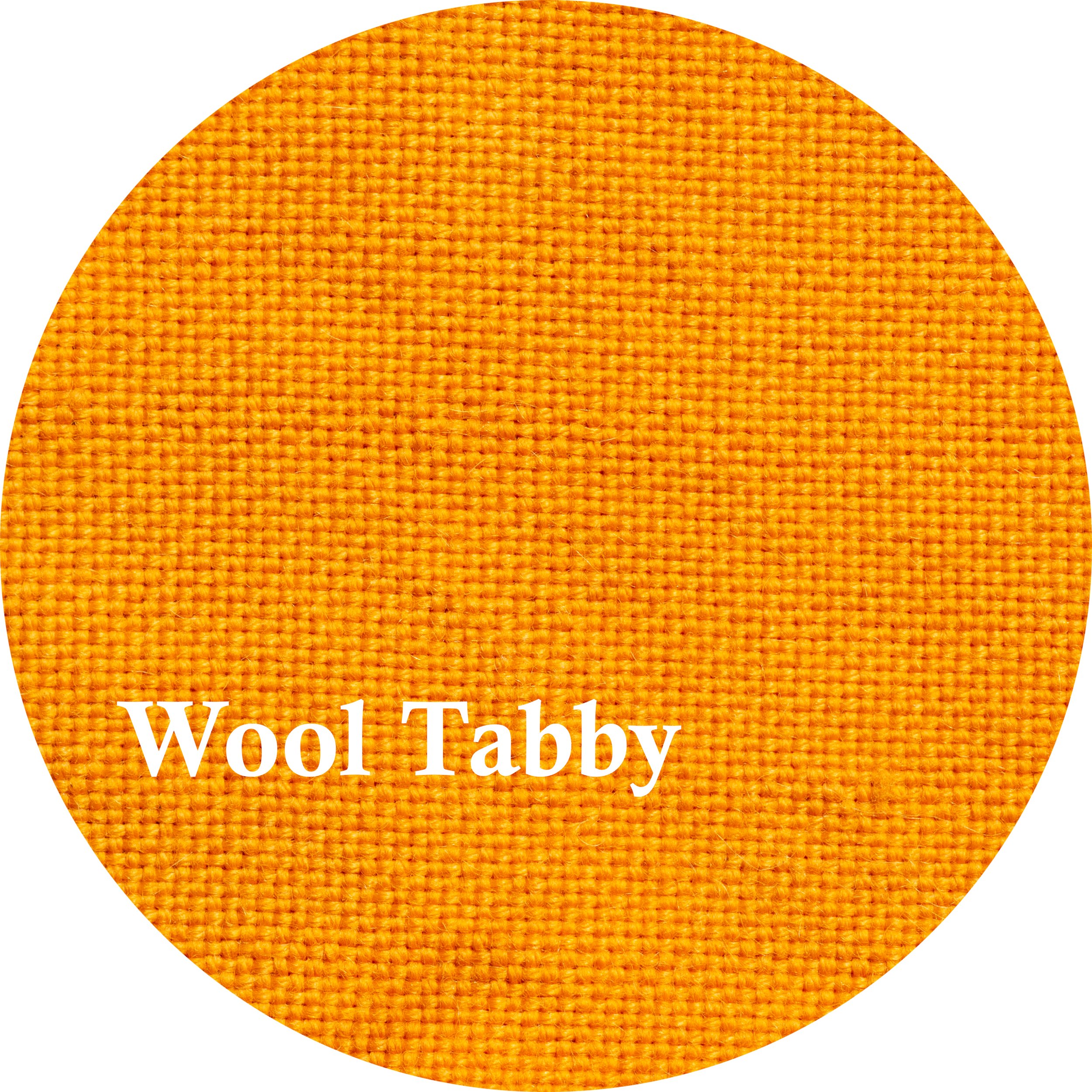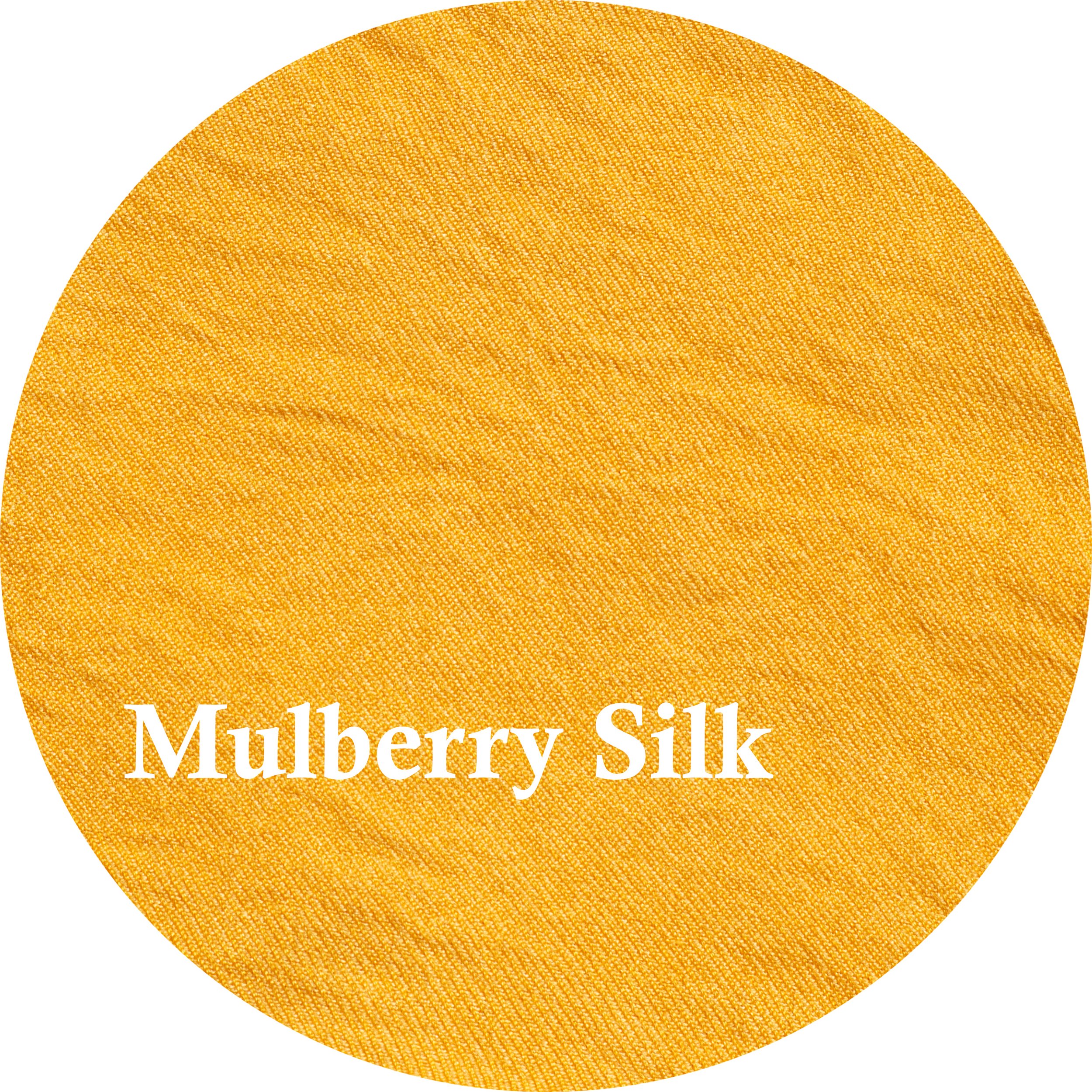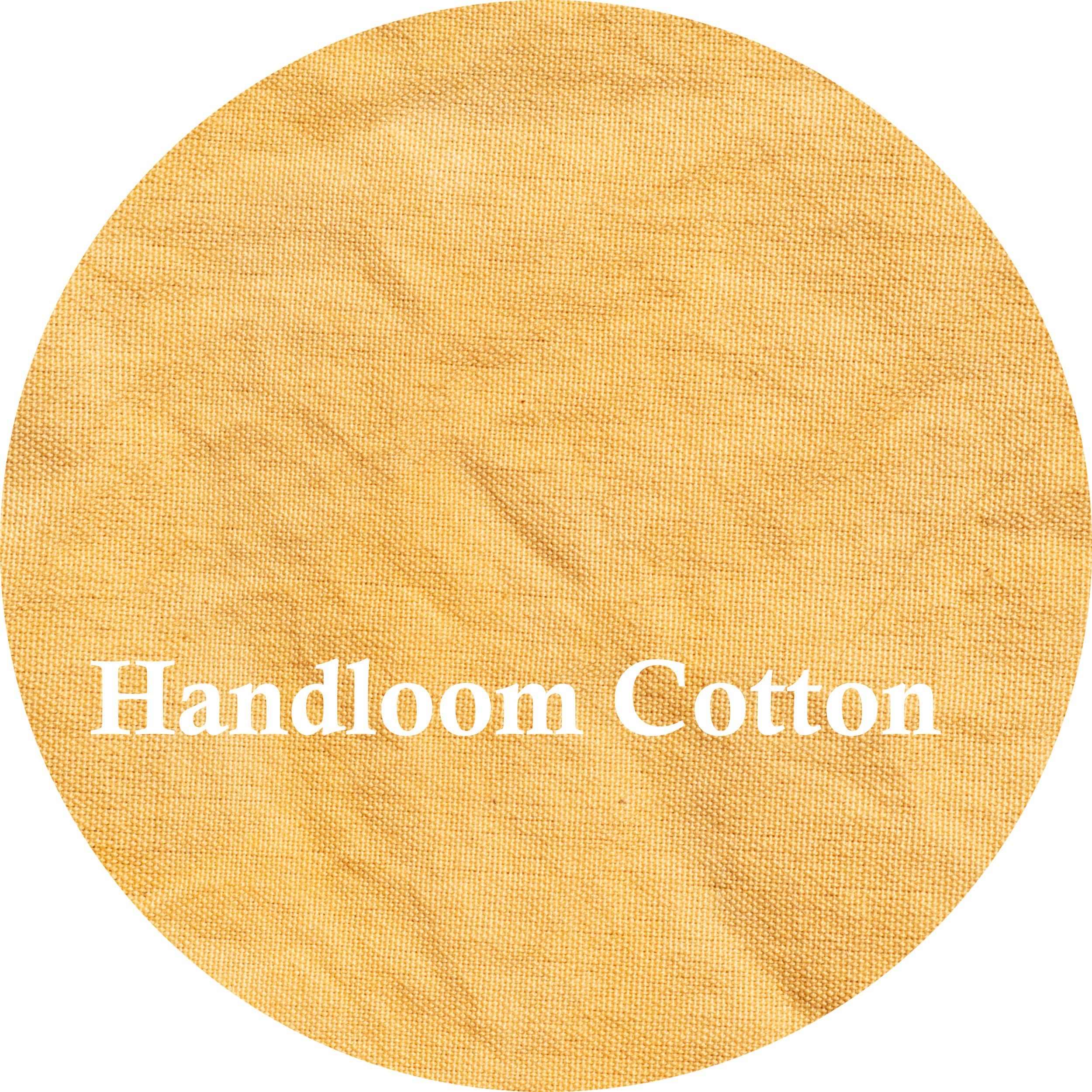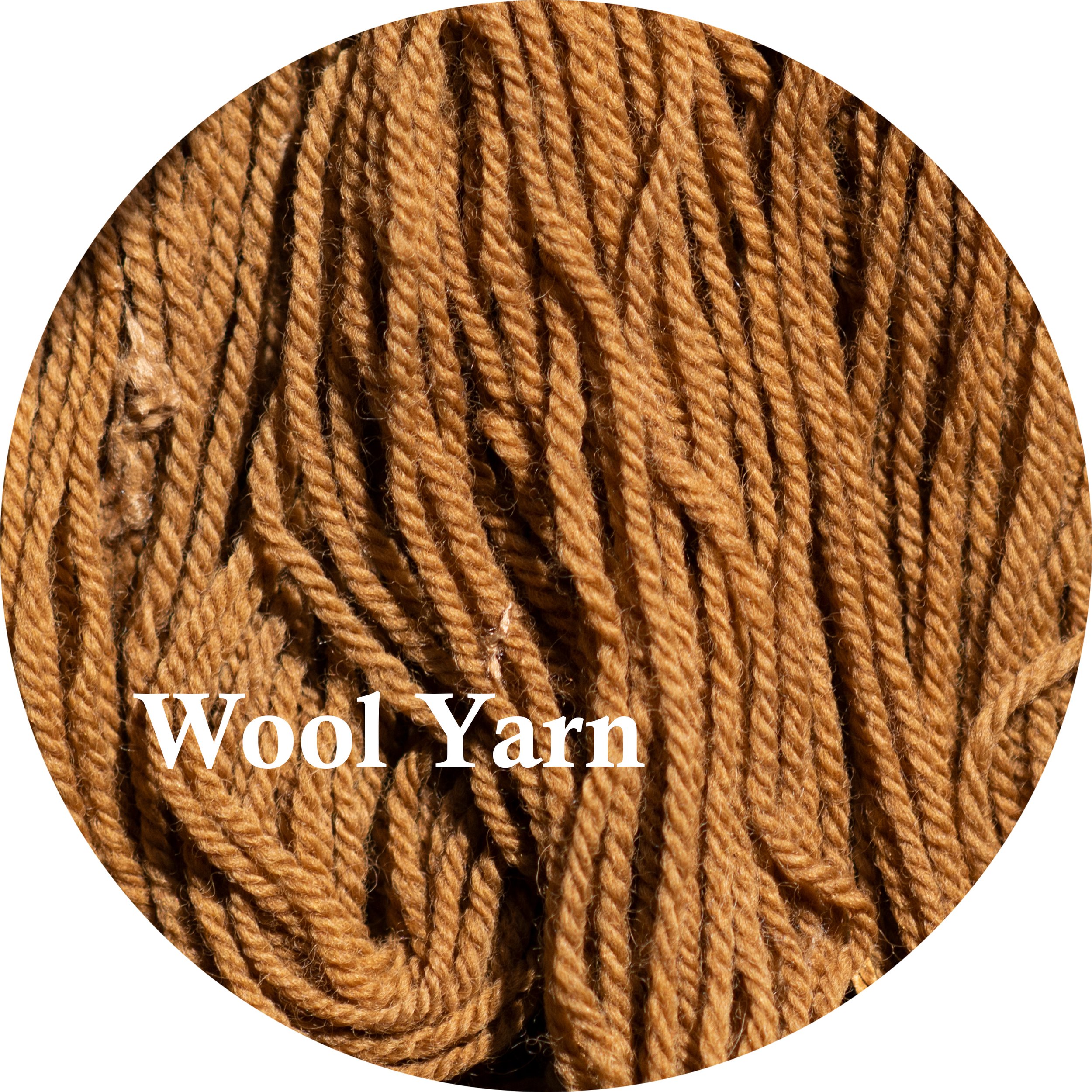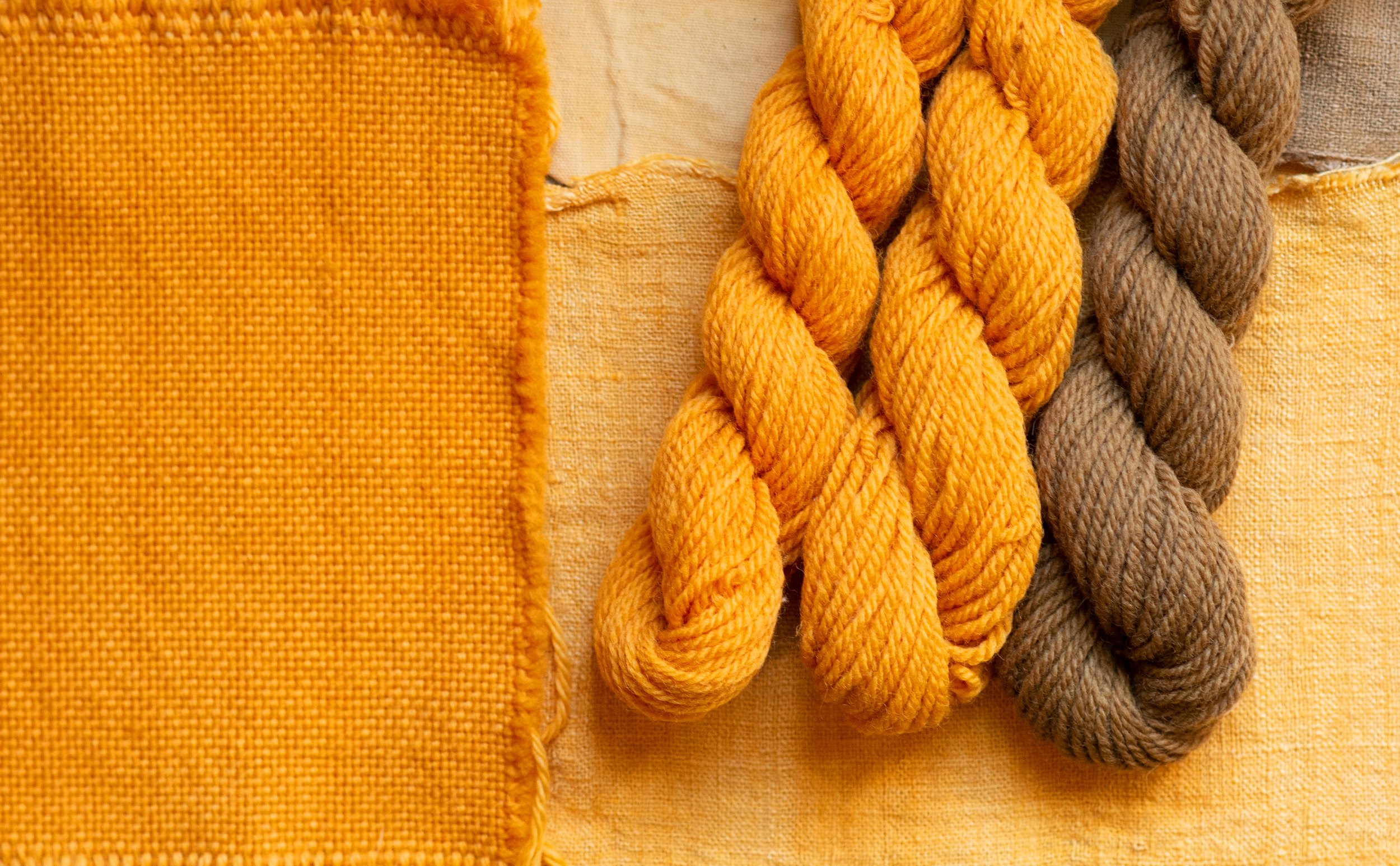
Kamala Fruit
A Guide to Kamala Fruit
Shepherd Textiles Kamala Fruit Natural Dye is made from the fruit of mallotus philippensis, a tropical tree native to Southeast Asia. The fruits of the kamala tree are protected by brightly colored red husks that contain a pigment called rottlerin. Rottlerin gives clear flame oranges and tangerine oranges on natural fibers, especially wool and silk. However, rottlerin is only soluble in alkaline solutions, and an alkaline modifier must be added to the dye bath to extract the color. Our ground kamala is the finest grade of red powder imported direct from India, and it gives strong colors using just 25% weight-of-fabric.
1. Background on Kamala Fruit
The kamala tree, mallotus philippensis, is a small tropical tree that is distributed widely across South and East Asia, from the Philippines in the east to as far west as Kashmir. The fruits of the tree have been appreciated for many centuries as the source of a natural orange dye for wool and silk, as well as for their medicinal value. In Ayurvedic medicine kamala is prescribed for the treatment of various skin problems like scabies and ringworm (Kumar et al. 2016:928-929), and it has been suggested that fabrics dyed with kamala might have beneficial qualities for the skin (ibid).
The main coloring compounds in kamala are contained in the red husks that surround the fruit. The husks contain two main pigments, rottlerin and isorottlerin, that give the fruit its brilliant color. Neither compound is water-soluble, but they are soluble in alcohol and alkalis. Applying the pigments to natural fibers can easily be accomplished by adding an alkaline modifier like soda ash to the dye bath. This will produce brilliant flame oranges on wool and bright tangerine colors on silk, although cotton tends to develop only pale orange shades.
Our ground kamala fruit husks are imported from India, and will give strong orange shades at 25% weight-of-fabric on wool and silk.
A Cheerful Tropical Dye
2. Safety Precautions
DO NOT INGEST. This product is intended for textile dyeing, not as an herbal supplement.
Ground kamala is an extremely fine, dusty powder; we recommend wearing a mask while working with it to avoid inhaling the dust. Open carefully to avoid spills or creating dust.
Avoid eye contact. If eye contact occurs, rinse with cool water.
Not for use as a cosmetic additive; do not apply directly to skin or hair.
If a spill occurs, quickly wipe up with a paper towel or disposable rag.
Use only dye pots and utensils dedicated to dyeing. Do not use any pots, containers, spoons, tongs, thermometers, or other utensils that will be used for food preparation.
Kamala fruit powder, and all dye baths and mordant liquors made while dyeing, should be kept out of reach of children and pets. Use only with adult supervision.
Shepherd Textiles, LLC is not liable for any misuse of this product or any unintended staining of your clothing, workspace, or other property. Use only as directed.
3. Recommended Supplies
Dye pot. Use a dye pot large enough to hold all your fibers, with plenty of room for them to move around and for the liquid to circulate freely.
Metal tongs. A pair of tongs is useful for stirring and taking fabric out. Use tongs dedicated to dyeing, and not for food preparation.
Rubber gloves. Wear rubber gloves while handling mordanted/dyed fiber before it has been rinsed.
Candy thermometer. The best way to keep track of temperature is to use a candy thermometer that clips to the side of the dye pot.
Scale. Use a scale to weigh out fiber, mordant, and dyestuff.
Alum mordant. The alum usually used for mordanting is aluminum potassium sulfate, also known as potash alum. It is the same alum that you can find in a jar in the spice section at the grocery store.
Soda ash. Also known as washing soda, soda ash will raise the PH of the dye bath enough to extract the orange rottlerin.
PH Strips. To confirm the dyebath is the correct PH (10).
4. Preparation: Mordanting with Alum
Kamala Fruit will dye wool and silk without a metal mordant, but a mordant will noticeably deepen the color and make it more lightfast. We recommend using alum, which will preserve the bright orange hues. If possible, soak your fibers in water for a few hours before mordanting, so that the mordant will penetrate deeply and evenly. Make sure to weigh the fibers first, while they are still dry.
For protein fibers (wool, silk, alpaca, etc.): Mordant at 12% WOF with alum.
Weigh out the fibers you plan to dye (while they are dry). Multiply that weight by 0.12 to get the amount of alum you will need.
Fill your dye pot with hot tap water, leaving enough room for the fiber.
Weigh out the correct amount of alum and pour it into the dye pot. Mix with a spoon or metal tongs until it has dissolved.
Gently place your fibers into the mordanting solution.
Heat mordant bath to 180F and maintain heat for 1 hour. If you don’t have a candy thermometer, you will have to estimate the temperature. At 180F, steam vapor will be rising off the water but it will not be bubbling. If your mordant bath starts to bubble, turn down the heat.
Stir every 15 or 20 minutes to make sure fibers mordant evenly. If they do not, the dye will take better in some places than others.
After an hour, remove from heat and let cool to room temperature. Once cool, you can immediately proceed to rinsing, or you can leave the fibers to steep overnight in the mordant bath. This can dramatically improve results, especially when dyeing thick or tightly woven fabrics.
When ready to rinse, put on rubber gloves and gently squeeze excess mordant solution back into the pot. Rinse fibers briefly in lukewarm water. The fiber does not need to be thoroughly washed, but any excess mordant should be rinsed out. Set aside until ready to dye. Keep out of reach of children and pets.
Dispose of mordant solution according to local guidelines.
For cellulose fibers (cotton, linen, etc.): Scour well and treat with a tannin before mordanting.
Kamala Fruit does not have a strong affinity for cellulose fibers and it tends to give pale shades on cotton, no matter thoroughly the cotton has been mordanted. To maximize the color depth and get soft orange crème shades, give cotton the full treatment of tanning and mordanting.
Scour cellulose fibers well. Traditionally this is done in a highly alkaline soda ash solution. Add 2 tsp of soda ash and 1 drop of dish soap to a 5-gallon dye pot. Add cellulose fibers and heat to 180F-190F for an hour, stirring occasionally. Remove from heat, and when cool enough to handle, rinse and wring out well. Household detergents like Tide© are also alkaline (PH 11), so you can also toss the fiber in a washing machine on a high-temperature cycle with plenty of detergent. This will not clean them nearly as deeply as simmering with soda ash, but it will yield much better results than not scouring at all.
Apply a clear tannin to the scoured fabric: Sumac Extract is the best choice as it will not alter the orange hue of Kamala Fruit. To use, fill your dye pot with hot water, dissolve 10% WOF Sumac Extract into the dye bath, simmer for an hour, then allow to cool. For best results, steep overnight. This process will make the cotton or linen more receptive to mordants. After steeping, remove fibers and rinse well.
Mordant with alum as described above for protein fibers.

The Recipes
5. Recipe: Flame
The basic recipe for Kamala Fruit is to use 25% weight-of-fabric of the powder in an alkaline dye bath. This will give brilliant orange shades on protein fibers. Note that ground kamala is an extremely fine dust—if you are dyeing yarn, you may wish to filter the dyebath through a coffee filter before adding the fibers.
Fill your dye pot with warm water.
Adjust the PH to 10 using soda ash. One teaspoon in a five-gallon dye pot is usually sufficient; confirm with PH strips.
Weigh out 25% weight-of-fabric (WOF) of Kamala Fruit powder. Add to the dyebath and mix well.
Heat the dyebath to 160F for half an hour, stirring occasionally, to extract the color from the powder. The bath should turn a deep, clear orange; if it does not, it is probably not alkaline enough. Allow to cool to room temperature.
[Optional] - At this point you may wish to filter the bath through cheesecloth or a large coffee filter to get out the tiny particles of ground fruit; otherwise they will have to be rinsed out at the end. This can become tedious, especially with yarn.
Add your pre-soaked and (optionally) pre-mordanted fibers.
Heat the dyebath to 180F. Maintain the heat for 90 minutes, stirring occasionally to make sure all the fibers dye evenly. After 90 minutes, take off the heat and allow to cool to room temperature.
When cool, remove the fibers and rinse briefly in lukewarm water. You can either proceed immediately to rinsing with detergent, or hang the fabric up to dry first to help the color set. Make sure to hang it up in the shade somewhere where dripping dye will cause no damage. Direct sunlight may fade the color before it has had time set.
For final rinsing, we recommend using a PH-neutral detergent like Synthrapol, which is designed to wash out loose dye. Follow the manufacturer’s directions for best results. CAUTION: Kamala Fruit will bleed if not thoroughly rinsed out after dyeing.
Hang up to dry out of direct sunlight.
6. Recipe: Khaki Green
Kamala Fruit responds well to an iron afterwash, which “saddens” the orange and shifts it to a khaki green. Similar colors can be achieved by mordanting with iron first rather than alum, although many dyers prefer not to mordant wool directly with iron because it can make it feel coarse.
Follow the recipe for “Flame” in Section 5, up to the point where the fibers have nearly finished dyeing,
Prepare a second dye pot with an iron solution. Choose a pot just big enough for the fibers to move around freely, and fill it 3/4 full with hot tap water. Weigh out 2% weight-of-fabric (WOF) of iron powder (ferrous sulfate) and add it to the pot*. Mix well until the powder is dissolved.
Heat the iron bath to 170F. Keeping it at about the same temperature as the main dyebath will prevent any temperature shocks to the fiber when it is transferred; this is especially important for preventing wool from felting.
Once the fibers have finished dyeing in the main dye bath, gently lift them out with tongs and place them in the iron bath.
Watch for the color shift; it should start in a minute or two. Depending on how tightly spun or thickly woven the fiber is, it should take between 5 and 15 minutes for the shift to be complete.
As soon as the color has shifted, remove the fibers from the iron bath so that they are not corroded by too much iron. We recommend having a pot of hot water ready to set them in to prevent any thermal shocks. Let cool to room temperature.
When cool, rinse the fibers well to get out any excess iron; wear rubber gloves. Afterwards, you can either proceed directly to a final rinsing with detergent, or you can hang the fabric up to dry first to help the color set. Make sure to hang it up in the shade somewhere where dripping dye will cause no damage. Direct sunlight may fade the color before it has had time set.
For final rinsing, we recommend using a PH-neutral detergent like Synthrapol, which is designed to wash out loose dye. Follow the manufacturer’s directions for best results. CAUTION: Kamala Fruit will bleed if not thoroughly rinsed out after dyeing.
Hang up to dry out of direct sunlight.
*NOTE: Iron powder is an irritant and may be harmful if ingested, especially for children and pets. Please read your manufacturer’s Safety Data Sheet (SDS) before using. Wear gloves, a mask, and eye protection when handling iron powder and iron mordant baths, and store out of reach of children.
All images and text are copyright of Shepherd Textiles, LLC. Do not reproduce without written permission and attribution.


